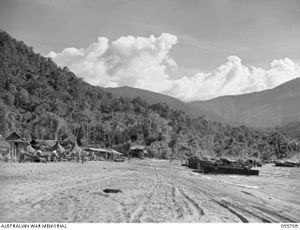| Landing at Nassau Bay | |||||||
|---|---|---|---|---|---|---|---|
| Part of World War II, Pacific War | |||||||
 Allied landing craft at Nassau Bay, August 1943 | |||||||
| |||||||
| Belligerents | |||||||
|
|
| ||||||
| Commanders and leaders | |||||||
|
|
| ||||||
| Units involved | |||||||
|
1/162nd Infantry Regiment 2/6th Infantry Battalion Papuan Infantry Battalion 2nd Engineer Special Brigade |
III/102nd Battalion III/66th Infantry Regiment | ||||||
| Strength | |||||||
| ~1,400 | ~ 600 | ||||||
| Casualties and losses | |||||||
| 23 killed, 27 wounded | ~ 76 killed | ||||||
The Landing at Nassau Bay was an amphibious landing by Allied forces at Nassau Bay during the New Guinea campaign of World War II that took place between 30 June and 6 July 1943. The operation was undertaken so that Allies could secure a beachhead to establish a supply point to shorten their supply lines for the proposed attack on Salamaua as part of the Salamaua–Lae campaign and resulted in a battalion-sized force of US infantry and supporting elements being landed largely unopposed on the south-eastern flank of the battle zone.
Due to bad weather, the landing force suffered heavy equipment losses with most of the US landing craft being wrecked in heavy seas. Nevertheless, the US troops were able to secure a lodgement from where they subsequently broke out, advancing north as part of a flanking drive on Salamaua, which was launched in conjunction with attacks by Australian forces further west. Australian forces also provided support during the landing, marking the landing beaches, and providing diversionary attacks against nearby Japanese forces. The landing was subsequently exploited with two more US infantry battalions being landed throughout early July, along with Australian and US artillery batteries, which were used to help reduce the Japanese positions around the Salamaua battle zone in the following months as the Allies sought to draw Japanese reinforcements away from Lae.